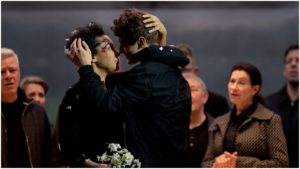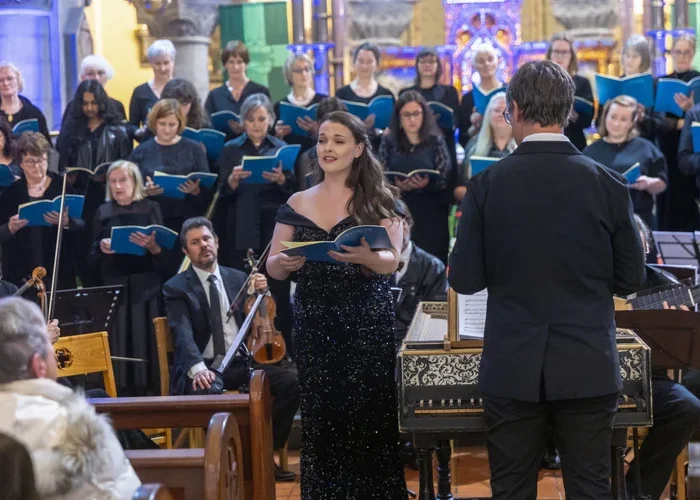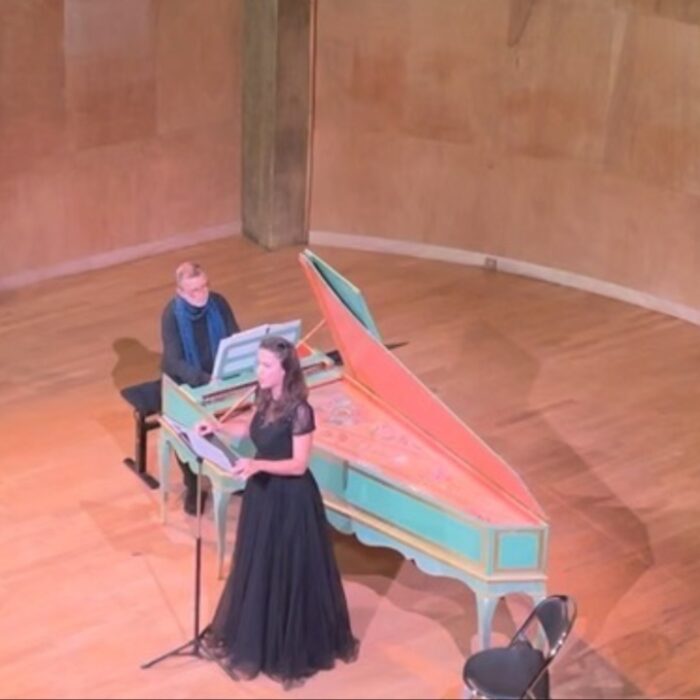
Royal Opera House 2021-22 Review: Theodora
Katie Mitchell’s Imaginative Vision is Blessed with Luxury Casting
By Benjamin Poore(Credit: © Camilla Greenwell, ROH 2022)
A much-publicized intimacy director; bold text warnings about sexual violence and “terrorist themes.” There was a certain gung-ho mood amongst the audience going into Katie Mitchell’s new production of Handel’s tragic oratorio “Theodora” at the Royal Opera House this week. The first performance of the work in Covent Garden for 272 years, in fact. What bracing horrors would we endure over the four-hour run time? What daring Regietheatre interventions would shock and unsettle? Add to this a lustrous cast – including Polish superstar countertenor Jakub Józef Orliński and queen bee mezzo Joyce DiDonato, no less – and the foyer was truly humming with anticipation.
In the end, it was considerably less gratuitous or brutal than the warnings might’ve had us imagine. Though Mitchell’s vision certainly didn’t lack for boldness and challenge – or, well, pole-dancing. There are plenty of quite serious interventions into text and story – not least the ending – born of Mitchell’s determined feminist practice in making and producing opera, which in this story seeks to confront the work’s misogyny head on.
A Modernistic Look at Handel
A contemporary setting – the Roman embassy in Antioch, all business suits and catering – teems with Mitchell’s naturalistic detailing. Theodora, Irene, and their accomplices are insurgents, religiously-motivated freedom fighters who delicately assemble a bomb to blow the place to Kingdom come in Act one in a stunningly detailed professional kitchen (kudos to Chloe Lamford for her sets). They are discovered; Theodora is imprisoned and sexually exploited, until her lover Didymus rescues her. He is himself caught by Septimius and Valens, the President; Theodora offers her life in exchange for Didymus to no avail, and Valens sentences them both to death.
Valens is a drunken lech who uses guns, money, and women to make himself feel big, fondling a (presumably) trafficked woman during his first aria. It is not a subtle characterization, but masculinity in this form seldom is. His equally abusive bodyguards assault Irene and Theodora when they are captured; in Act two the latter is raped offstage in a tacky red boudoir fitted with poles for yet more sexual spectacle. There are cartoonish versions of femininity too: Theodora (and then Didymus, to aid her escape) is dressed in a ghastly sparkling dress and cheap blonde wig when she is captured.
It’s a production whose feminist bent aims to give us more of Theodora’s subjectivity, telling the story, from the overture on, with her in the picture. As an armed insurrectionist, she is much transformed from the meek martyr of Thomas Morell’s original scenario. In one Act two sequence, she nearly effects an armed escape from her captors. So too is the character of Irene thoroughly fleshed out, a kind of spiritual leader supporting activist Theodora, baptizing Didymus at the end of Act one, and leading the Christians in their vigil for their captured warrior. Mitchell elides the two choruses of the original – Heathens and Christians – into one, the waiting and kitchen staff who support the decadent regime above, and, at the climax, violently take their revenge.
Mitchell’s stylistic hallmarks – though what director doesn’t have them? – are there, not least the slow-motion movement used to such incredibly powerful effect at the climax of George Benjamin’s “Written on Skin.” Most dramatic is Mitchell’s transformation of the ending – rather than perishing in the kitchen freezer, Irene and her colleagues slaughter the guards and bust out Didymas and Theodora, in a slow-motion bloodbath worthy of “Platoon,” as they sing their final duet. Slowing down the action allows it to gel with the reflective character of the work’s aria (a similar effect is achieved in Act one as the bodyguards discover Theodora and Irene assembling the bomb and apprehend them); it generates a kind of narrative ebb that builds in intensity across Mitchell’s long tableaus. By the same token, it can make a long work feel, well, rather long. The physical discipline of all the performers involved is laudable, and movement director Sarita Piotrowski has done a fine job with the cast.
The sliding boxes of this doll’s house set allow Mitchell’s parallel storytelling to take hold, which coupled with meticulous physical direction and Handel’s ruminative arias – there are a lot of slow pieces in “Theodora” – mean the eye is captivated throughout. Of course, what makes this a success can also make it a weakness. At its best, this technique deepens and unfurls Morell’s text through Mitchell’s psychological acuity. Didymus’ Act two aria ‘Deeds of kindness to display’ was heart-rending in this respect. In this staging, his plea for clemency and kindness is directed towards the goons guarding the door and preventing him from seeing Theodora. On the other side of the partition, we see the bruised and degraded Theodora, who has just been raped, comforted, cleaned, and held with the utmost tenderness by the other woman in the room, the pole-dancer from the previous scene, who has remained throughout.
It’s a scene that unfolds different kinds of tenderness and care, and moments like this across the show give it a multi-dimensional quality. Mitchell’s deep-diving Stanislavskian process is one evident display. At other points, this works against Handel’s fabulous score. The stage is made over-busy and burdened with action, and we struggle to focus on the extraordinary artistry on display in the show (more on which later). Pole-dancers offer an uneasy spectacle during Theodora’s Act two lament about her situation, and their business throughout the Act – though superlatively athletic – feels rather overcooked; so too is seeing Orliński receive pole-dancing lessons while the chorus laments.
Characters are often onstage for a very long time; this intensifies the naturalist mood of Mitchell’s work and gives characters texture and groundedness. So too does it help swell the tidal waves of Mitchell’s narratives, woven into and around the music, and works particularly well in the slow-burn music of this oratorio. There are the rhythms of work: rows of glasses filled with champagne, ranks of coffee cups, polished worktops. It is not just religious discrimination that drives the action, but the accumulating energies of class resentment too.
A Fine Cast
Julia Bullock led one of the finest casts recently assembled on this stage. Vocally there is steel, in keeping with character’s determination, albeit metal wrapped in the finest freshly-laundered linen, soft and pure in moments of religious rapture. It was a performance of utmost sincerity and intensity. In the final duet with Orliński, tangled on top of each other, she folded her sound exquisitely into his great creamy strips of vellum. It’s a big house for Orliński’s voice, which didn’t always cut the orchestra’s relative richness. His text was a little uncertain in the recitatives, where he was considerably less comfortable (an ‘unrivaled’ became ‘unraveled’ at one point). But it was hardly an off night, barring a little singing under the note – his opening unaccompanied phrase of the “The raptur’d soul” was pure luxury. Some of his choicest moments were the sparest – singing alongside the theorbo and wafts of solo strings in Act two.
Joyce DiDonato is already an expert in this repertoire and offered a definitive performance. Her breath control is such that Handel’s melodic lines unspool like the finest velvet. The standout moment of the entire evening, from a musical point of view, was her unaccompanied, searching cadenza in ‘Lord, to Thee each night and day:’ a moment of hair-raising intimacy and softness.
Ed Lyon sang Septimius with forthright confidence, as well as lightness and flexibility. His occasional forays into falsetto for his top notes will not be to everyone’s taste, but there was clarity and control on show throughout, even if there were a few strains showing by the (admittedly spectacular) final aria, imploring Theodora not to shoot herself. Gyula Orendt has a rather onerous task as the bad guy, not helped by Mitchell’s slightly over-egged characterization (does he really need to slap his goons about the face with wads of cash in his first solo number?), but musically was well up to the task, apart from some slightly awkwardly shaped vowels.
Sometimes baroque repertoire in this house brings in other forces (the orchestra of the London Handel Festival and the OAE sometimes grace the building), but not this time, with Harry Bicket directing the in-house band. A mix of modern and period sounds helped the score take flight in a house where threadbare historical stylings can get a little lost. Modern strings and woodwinds afforded a slightly meatier and more luminous sound, which worked especially well as an accompaniment to the choruses; Bicket has a wonderful feeling for textural contrast, sometimes calling forth diaphanous clouds, at others the lush and languid. Instrumental spotlights landed on discreet use of the continuo, one of DiDonato’s standout arias concluded with solo cello and a brush of theorbo.
A few chorus numbers were cut in this production, but ROH forces excelled themselves, as is so essential in oratorio. Theirs is a hefty sound, full of tragic portent and prayerful seriousness, and hugely atmospheric in the closing scenes of each Act. Musical standards are almost unimpeachable, and Mitchell’s production, whatever its foibles, will be amongst the most thought-provoking we will likely see this year in London.



